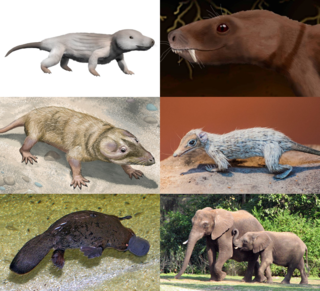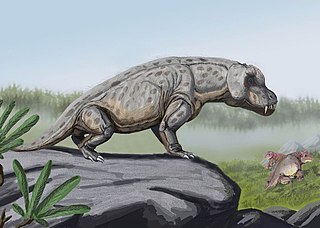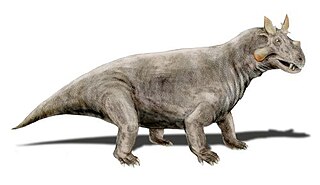
Synapsids are one of the two major clades of vertebrate animals in the group Amniota, the other being the sauropsids, which include reptiles and birds. The synapsids were once the dominant land animals in the late Paleozoic and early Mesozoic, but the only extant group that survived into the Cenozoic are the mammals. Unlike other amniotes, synapsids have a single temporal fenestra, an opening low in the skull roof behind each eye orbit, leaving a bony arch beneath each; this accounts for their name. The distinctive temporal fenestra developed about 318 million years ago during the Late Carboniferous period, when synapsids and sauropsids diverged, but was subsequently merged with the orbit in early mammals.

A therapsid is a member of the clade Therapsida which is a major group of eupelycosaurian synapsids that includes mammals and their ancestors and relatives. Many of the traits today seen as unique to mammals had their origin within early therapsids, including limbs that were oriented more underneath the body, as opposed to the sprawling posture of many reptiles and salamanders.

Cynodonts are eutheriodont therapsids belonging to the clade Cynodontia that first appeared in the Late Permian, and extensively diversified after the Permian–Triassic extinction event. Cynodonts occupied a variety of ecological niches, both as carnivores and as herbivores. Mammals are cynodonts, as are their extinct ancestors and close relatives (Mammaliaformes), having evolved from advanced probainognathian cynodonts during the Late Triassic. All other cynodont lines went extinct, with the last known non-mammaliaform cynodont group, the Tritylodontidae, having its youngest records in the Early Cretaceous.

Eucynodontia is a clade of cynodont therapsids including mammals and most non-mammalian cynodonts. The oldest eucynodonts are known from the Early Triassic and possibly Late Permian. Eucynodontia includes two major subgroups, Cynognathia and Probainognathia.

Gorgonopsia is an extinct clade of sabre-toothed therapsids from the Middle to Upper Permian roughly 265 to 252 million years ago. They are characterised by a long and narrow skull, as well as elongated upper and sometimes lower canine teeth and incisors which were likely used as slashing and stabbing weapons. Postcanine teeth are generally reduced or absent. For hunting large prey, they possibly used a bite-and-retreat tactic, ambushing and taking a debilitating bite out of the target, and following it at a safe distance before its injuries exhausted it, whereupon the gorgonopsian would grapple the animal and deliver a killing bite. They would have had an exorbitant gape, possibly in excess of 90°, without having to unhinge the jaw.

Biarmosuchia is an extinct clade of non-mammalian synapsids from the Permian. Biarmosuchians are the most basal group of the therapsids. They were moderately-sized, lightly built carnivores, intermediate in form between basal sphenacodont "pelycosaurs" and more advanced therapsids. Biarmosuchians were rare components of Permian ecosystems, and the majority of species belong to the clade Burnetiamorpha, which are characterized by elaborate cranial ornamentation.

Anteosaurs are a group of large, primitive carnivorous dinocephalian therapsids with large canines and incisors and short limbs, that are known from the Middle Permian of South Africa, Russia, China, and Brazil. Some grew very large, with skulls 50–80 centimetres (20–31 in) long, and were the largest predators of their time. They died out at the end of the Middle Permian, possibly as a result of the extinction of the herbivorous Tapinocephalia on which they may have fed.

Ericiolacerta is an extinct genus of small therocephalian therapsids from the early Triassic of South Africa and Antarctica. Ericiolacerta, meaning "hedgehog lizard", was named by D.M.S. Watson in 1931. The species E. parva is known from the holotype specimen which consists of a nearly complete skeleton found in the Lystrosaurus Assemblage Zone within the Katberg Formation of the Beaufort Group in South Africa, and from a partial jaw found in the Lower Triassic Fremouw Formation in Antarctica. Ericiolacerta was around 20 centimetres (7.9 in) in length, with long limbs and relatively small teeth. It probably ate insects and other small invertebrates. The therocephalians – therapsids with mammal-like heads – were abundant in Permian times, but only a few made it into the Triassic. Ericiolacerta was one of those. It is possible that they gave rise to the cynodonts, the only therapsid group to survive into post-Triassic times. Cynodonts gave rise to mammals.

Therocephalia is an extinct clade of eutheriodont therapsids from the Permian and Triassic. The therocephalians ("beast-heads") are named after their large skulls, which, along with the structure of their teeth, suggest that they were carnivores. Like other non-mammalian synapsids, therocephalians were once described as "mammal-like reptiles". Therocephalia is the group most closely related to the cynodonts, which gave rise to the mammals. This relationship takes evidence in a variety of skeletal features.

The theriodonts are a major group of therapsids which appeared during the Middle Permian and which includes the gorgonopsians and the eutheriodonts, itself including the therocephalians and the cynodonts.

Procynosuchidae is an extinct family of therapsids which, along with Dviniidae, were the earliest cynodonts. They appeared around 260 million years ago, and were most abundant during the latest Permian time, shortly before the Permian-Triassic extinction event. Despite being the basal member of the cynodont clade, they already showed some of the advanced mammalian characteristics, but Procynosuchids bore resemblance to the Therocephalians.

Estemmenosuchidae is an extinct family of large, very early herbivorous therapsids that flourished during the Guadalupian period. They are distinguished by horn-like structures, probably for display or agonistic behavior. Apart from the best known genus, Estemmenosuchus, the group is poorly known. To date, their fossils are known only from the Perm region of Russia.

Eutherocephalia is an extinct clade of advanced therocephalian therapsids. Eutherocephalians are distinguished from the lycosuchids and scylacosaurids, two early therocephalian families. While lycosuchids and scyalosaurids became extinct by the end of the Permian period, eutherocephalians survived the Permian–Triassic extinction event. The group eventually became extinct in the Middle Triassic.
James Allen Hopson is an American paleontologist and professor at the University of Chicago. His work has focused on the evolution of the synapsids, and has been focused on the transition from basal synapsids to mammals, from the late Paleozoic through the Mesozoic Eras. He received his doctorate at Chicago in 1965, and worked at Yale before returning to Chicago in 1967 as a faculty member in Anatomy, and has also been a research associate at the Field Museum of Natural History since 1971. He has also worked on the paleobiology of dinosaurs, and his work, along with that of Peter Dodson, has become a foundation piece for the modern understanding of duckbill crests, social behavior, and variation.

Moschorhinus is an extinct genus of therocephalian in the family Akidnognathidae with only one species: M. kitchingi. It was a carnivorous synapsid which has been found in the Late Permian to Early Triassic of the South African Karoo Supergroup. It was a large carnivore, reaching 1.5 m (4.9 ft) in total body length with the largest skull comparable to that of a lion in size. It had a broad, blunt snout which bore long, straight canines. It appears to have replaced the gorgonopsids ecologically, and hunted much like a big cat. While most abundant in the Late Permian, it survived a little after the Permian Extinction, though these Triassic individuals had stunted growth.

Theriognathus is an extinct genus of therocephalian therapsid belonging to the family Whaitsiidae, known from fossils from South Africa, Zambia, and Tanzania. Theriognathus has been dated as existing during the Late Permian. Although Theriognathus means mammal jaw, the lower jaw is actually made up of several bones as seen in modern reptiles, in contrast to mammals. Theriognathus displayed many different reptilian and mammalian characteristics. For example, Theriognathus had canine teeth like mammals, and a secondary palate, multiple bones in the mandible, and a typical reptilian jaw joint, all characteristics of reptiles. It is speculated that Theriognathus was either carnivorous or omnivorous based on its teeth, and was suited to hunting small prey in undergrowth. This synapsid adopted a sleek profile of a mammalian predator, with a narrow snout and around 1 meter long. Theriognathus is represented by 56 specimens in the fossil record.

Glanosuchus is a genus of scylacosaurid therocephalian from the Late Permian of South Africa. The type species G. macrops was named by Robert Broom in 1904. Glanosuchus had a middle ear structure that was intermediate between that of early therapsids and mammals. Ridges in the nasal cavity of Glanosuchus suggest it had an at least partially endothermic metabolism similar to modern mammals.

Lumkuia is an extinct genus of cynodonts, fossils of which have been found in the Cynognathus Assemblage Zone of the Beaufort Group in the South African Karoo Basin that date back to the early Middle Triassic. It contains a single species, Lumkuia fuzzi, which was named in 2001 on the basis of the holotype specimen BP/1/2669, which can now be found at the Bernard Price Institute in Johannesburg, South Africa. The genus has been placed in its own family, Lumkuiidae. Lumkuia is not as common as other cynodonts from the same locality such as Diademodon and Trirachodon.

Raranimus is an extinct genus of therapsids of the Middle Permian. It was described in 2009 from a partial skull found in 1998 from the Dashankou locality of the Qingtoushan Formation, outcropping in the Qilian Mountains of Gansu, China. The genus is the most basal known member of the clade Therapsida, to which the later Mammalia belong.

Bauriidae is an extinct family of therocephalian therapsids. Bauriids were the latest-surviving group of therocephalians after the Permian–Triassic extinction event, going extinct in the Middle Triassic. They are among the most advanced eutherocephalians and possess several mammal-like features such as a secondary palate and wide postcanine teeth at the back of the jaws. Unlike other therocephalians, bauriids were herbivorous. They were also smaller than earlier members of the group. Two subfamilies are classified within Bauriidae: Nothogomphodontinae and Bauriinae.


























